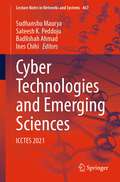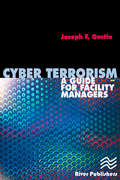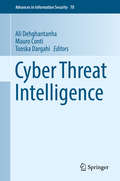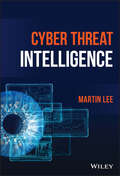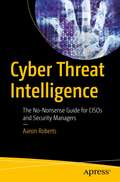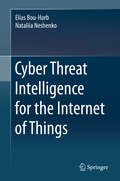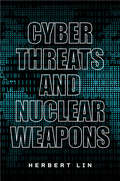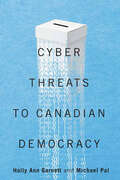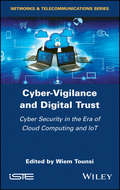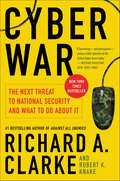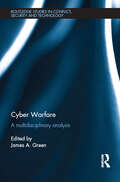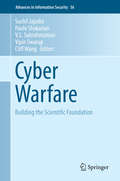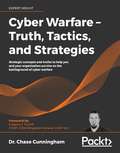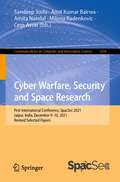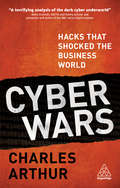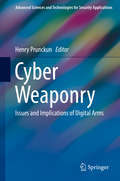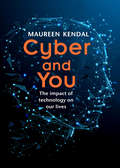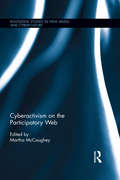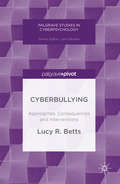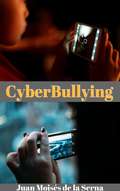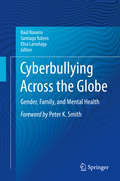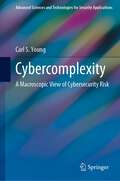- Table View
- List View
Cyber Technologies and Emerging Sciences: ICCTES 2021 (Lecture Notes in Networks and Systems #467)
by Sudhanshu Maurya Sateesh K. Peddoju Badlishah Ahmad Ines ChihiThe book is a collection of best selected research papers presented at International Conference on Cyber-Technologies and Emerging Sciences (ICCTES 2021), organized by Graphic Era Hill University, Bhimtal Campus, Uttarakhand, India, during 17 – 18 December 2021. The book covers state-of-the-art applications, innovative methods, and analyze the unexplored and unsolved challenges to establish the relative solutions to advance the existing applications and theories of Cyber-Technologies and Emerging Sciences.
Cyber Terrorism: A Guide for Facility Managers
by Joseph F. GustinCyber Terrorism: A Guide for Facility Managers addresses cyberterrorism and other forms of terrorist activity including mailroom security, bomb threats, and the constant attacks from viruses, hackers, and other invasive programs.
Cyber Threat Intelligence (Advances in Information Security #70)
by Ali Dehghantanha Mauro Conti Tooska DargahiThis book provides readers with up-to-date research of emerging cyber threats and defensive mechanisms, which are timely and essential. It covers cyber threat intelligence concepts against a range of threat actors and threat tools (i.e. ransomware) in cutting-edge technologies, i.e., Internet of Things (IoT), Cloud computing and mobile devices. This book also provides the technical information on cyber-threat detection methods required for the researcher and digital forensics experts, in order to build intelligent automated systems to fight against advanced cybercrimes.The ever increasing number of cyber-attacks requires the cyber security and forensic specialists to detect, analyze and defend against the cyber threats in almost real-time, and with such a large number of attacks is not possible without deeply perusing the attack features and taking corresponding intelligent defensive actions – this in essence defines cyber threat intelligence notion. However, such intelligence would not be possible without the aid of artificial intelligence, machine learning and advanced data mining techniques to collect, analyze, and interpret cyber-attack campaigns which is covered in this book. This book will focus on cutting-edge research from both academia and industry, with a particular emphasis on providing wider knowledge of the field, novelty of approaches, combination of tools and so forth to perceive reason, learn and act on a wide range of data collected from different cyber security and forensics solutions. This book introduces the notion of cyber threat intelligence and analytics and presents different attempts in utilizing machine learning and data mining techniques to create threat feeds for a range of consumers. Moreover, this book sheds light on existing and emerging trends in the field which could pave the way for future works. The inter-disciplinary nature of this book, makes it suitable for a wide range of audiences with backgrounds in artificial intelligence, cyber security, forensics, big data and data mining, distributed systems and computer networks. This would include industry professionals, advanced-level students and researchers that work within these related fields.
Cyber Threat Intelligence
by Martin LeeCYBER THREAT INTELLIGENCE “Martin takes a thorough and focused approach to the processes that rule threat intelligence, but he doesn’t just cover gathering, processing and distributing intelligence. He explains why you should care who is trying to hack you, and what you can do about it when you know.” —Simon Edwards, Security Testing Expert, CEO SE Labs Ltd., Chair AMTSO Effective introduction to cyber threat intelligence, supplemented with detailed case studies and after action reports of intelligence on real attacks Cyber Threat Intelligence introduces the history, terminology, and techniques to be applied within cyber security, offering an overview of the current state of cyberattacks and stimulating readers to consider their own issues from a threat intelligence point of view. The author takes a systematic, system-agnostic, and holistic view to generating, collecting, and applying threat intelligence. The text covers the threat environment, malicious attacks, collecting, generating, and applying intelligence and attribution, as well as legal and ethical considerations. It ensures readers know what to look out for when considering a potential cyber attack and imparts how to prevent attacks early on, explaining how threat actors can exploit a system’s vulnerabilities. It also includes analysis of large scale attacks such as WannaCry, NotPetya, Solar Winds, VPNFilter, and the Target breach, looking at the real intelligence that was available before and after the attack. Topics covered in Cyber Threat Intelligence include: The constant change of the threat environment as capabilities, intent, opportunities, and defenses change and evolve Different business models of threat actors, and how these dictate the choice of victims and the nature of their attacks Planning and executing a threat intelligence programme to improve an organistation’s cyber security posture Techniques for attributing attacks and holding perpetrators to account for their actions Cyber Threat Intelligence describes the intelligence techniques and models used in cyber threat intelligence. It provides a survey of ideas, views and concepts, rather than offering a hands-on practical guide. It is intended for anyone who wishes to learn more about the domain, particularly if they wish to develop a career in intelligence, and as a reference for those already working in the area.
Cyber Threat Intelligence: The No-Nonsense Guide for CISOs and Security Managers
by Aaron RobertsUnderstand the process of setting up a successful cyber threat intelligence (CTI) practice within an established security team. This book shows you how threat information that has been collected, evaluated, and analyzed is a critical component in protecting your organization’s resources. Adopting an intelligence-led approach enables your organization to nimbly react to situations as they develop. Security controls and responses can then be applied as soon as they become available, enabling prevention rather than response. There are a lot of competing approaches and ways of working, but this book cuts through the confusion. Author Aaron Roberts introduces the best practices and methods for using CTI successfully. This book will help not only senior security professionals, but also those looking to break into the industry. You will learn the theories and mindset needed to be successful in CTI. This book covers the cybersecurity wild west, the merits and limitations of structured intelligence data, and how using structured intelligence data can, and should, be the standard practice for any intelligence team. You will understand your organizations’ risks, based on the industry and the adversaries you are most likely to face, the importance of open-source intelligence (OSINT) to any CTI practice, and discover the gaps that exist with your existing commercial solutions and where to plug those gaps, and much more. What You Will Learn Know the wide range of cybersecurity products and the risks and pitfalls aligned with blindly working with a vendorUnderstand critical intelligence concepts such as the intelligence cycle, setting intelligence requirements, the diamond model, and how to apply intelligence to existing security informationUnderstand structured intelligence (STIX) and why it’s important, and aligning STIX to ATT&CK and how structured intelligence helps improve final intelligence reportingKnow how to approach CTI, depending on your budgetPrioritize areas when it comes to funding and the best approaches to incident response, requests for information, or ad hoc reportingCritically evaluate services received from your existing vendors, including what they do well, what they don’t do well (or at all), how you can improve on this, the things you should consider moving in-house rather than outsourcing, and the benefits of finding and maintaining relationships with excellent vendors Who This Book Is For Senior security leaders in charge of cybersecurity teams who are considering starting a threat intelligence team, those considering a career change into cyber threat intelligence (CTI) who want a better understanding of the main philosophies and ways of working in the industry, and security professionals with no prior intelligence experience but have technical proficiency in other areas (e.g., programming, security architecture, or engineering)
Cyber Threat Intelligence for the Internet of Things
by Elias Bou-Harb Nataliia NeshenkoThis book reviews IoT-centric vulnerabilities from a multidimensional perspective by elaborating on IoT attack vectors, their impacts on well-known security objectives, attacks which exploit such vulnerabilities, coupled with their corresponding remediation methodologies. This book further highlights the severity of the IoT problem at large, through disclosing incidents of Internet-scale IoT exploitations, while putting forward a preliminary prototype and associated results to aid in the IoT mitigation objective. Moreover, this book summarizes and discloses findings, inferences, and open challenges to inspire future research addressing theoretical and empirical aspects related to the imperative topic of IoT security.At least 20 billion devices will be connected to the Internet in the next few years. Many of these devices transmit critical and sensitive system and personal data in real-time. Collectively known as “the Internet of Things” (IoT), this market represents a $267 billion per year industry. As valuable as this market is, security spending on the sector barely breaks 1%. Indeed, while IoT vendors continue to push more IoT devices to market, the security of these devices has often fallen in priority, making them easier to exploit. This drastically threatens the privacy of the consumers and the safety of mission-critical systems.This book is intended for cybersecurity researchers and advanced-level students in computer science. Developers and operators working in this field, who are eager to comprehend the vulnerabilities of the Internet of Things (IoT) paradigm and understand the severity of accompanied security issues will also be interested in this book.
Cyber Threats and Nuclear Weapons
by Herbert LinThe technology controlling United States nuclear weapons predates the Internet. Updating the technology for the digital era is necessary, but it comes with the risk that anything digital can be hacked. Moreover, using new systems for both nuclear and non-nuclear operations will lead to levels of nuclear risk hardly imagined before. This book is the first to confront these risks comprehensively. With Cyber Threats and Nuclear Weapons, Herbert Lin provides a clear-eyed breakdown of the cyber risks to the U.S. nuclear enterprise. Featuring a series of scenarios that clarify the intersection of cyber and nuclear risk, this book guides readers through a little-understood element of the risk profile that government decision-makers should be anticipating. What might have happened if the Cuban Missile Crisis took place in the age of Twitter, with unvetted information swirling around? What if an adversary announced that malware had compromised nuclear systems, clouding the confidence of nuclear decision-makers? Cyber Threats and Nuclear Weapons, the first book to consider cyber risks across the entire nuclear enterprise, concludes with crucial advice on how government can manage the tensions between new nuclear capabilities and increasing cyber risk. This is an invaluable handbook for those ready to confront the unique challenges of cyber nuclear risk.
Cyber-Threats to Canadian Democracy (McGill-Queen's/Brian Mulroney Institute of Government Studies in Leadership, Public Policy, and Governance)
by Holly Ann Garnett and Michael PalFrom the Cambridge Analytica scandal to overloaded internet voting servers to faulty voting machines, the growing relationship between democracy and technology has brought to light the challenges associated with integrating new digital tools into the electoral system. Canadian politics has also felt the impact of this migration online.This timely book presents the first comprehensive study of the various cyber-threats to election integrity across Canadian jurisdictions. Scrutinizing the events of the 2019 federal election, Cyber-Threats to Canadian Democracy examines how new technologies have affected the practice of electoral politics and what we can do to strengthen future Canadian elections. Through the disciplines of political science, law, computer science, engineering, communications, and others, chapters shed light on some of the most contentious issues around technology and electoral integrity. The contributors address current domestic and foreign threats to Canadian elections, evaluate the behaviour of actors ranging from political parties and interest groups to policymakers and election administrators, and assess emerging legal and regulatory responses while anticipating future challenges to the quality of elections in Canada and around the globe.Cyber-Threats to Canadian Democracy helps seed the study of digital technology’s security risks, providing insight into what reforms are needed and evaluating existing legal and policy frameworks in light of these threats.
Cyber-Vigilance and Digital Trust: Cybersecurity in the Era of Cloud Computing and IoT
by Wiem TounsiCyber War: The Next Threat to National Security and What to Do About It
by Richard A. Clarke Robert K. KnakeAn essential, eye-opening book about cyberterrorism, cyber war, and the next great threat to our national security. “Cyber War may be the most important book about national security policy in the last several years.” –SlateFormer presidential advisor and counter-terrorism expert Richard A. Clarke sounds a timely and chilling warning about America’s vulnerability in a terrifying new international conflict. Cyber War is a powerful book about technology, government, and military strategy; about criminals, spies, soldiers, and hackers. It explains clearly and convincingly what cyber war is, and how vulnerable we are as a nation and as individuals to the vast and looming web of cyber criminals.Every concerned American should read this startling and explosive book that offers an insider’s view of White House ‘Situation Room’ operations and carries the reader to the frontlines of our cyber defense. Cyber War exposes a virulent threat to our nation’s security.
Cyber Warfare: A Multidisciplinary Analysis (Routledge Studies in Conflict, Security and Technology)
by James GreenThis book is a multi-disciplinary analysis of cyber warfare, featuring contributions by leading experts from a mixture of academic and professional backgrounds. Cyber warfare, meaning interstate cyber aggression, is an increasingly important emerging phenomenon in international relations, with state-orchestrated (or apparently state-orchestrated) computer network attacks occurring in Estonia (2007), Georgia (2008) and Iran (2010). This method of waging warfare – given its potential to, for example, make planes fall from the sky or cause nuclear power plants to melt down – has the capacity to be as devastating as any conventional means of conducting armed conflict. Every state in the world now has a cyber-defence programme and over 120 states also have a cyber-attack programme. While the amount of literature on cyber warfare is growing within disciplines, our understanding of the subject has been limited by a lack of cross-disciplinary engagement. In response, this book, drawn from the fields of computer science, military strategy, international law, political science and military ethics, provides a critical overview of cyber warfare for those approaching the topic from whatever angle. Chapters consider the emergence of the phenomena of cyber warfare in international affairs; what cyber-attacks are from a technological standpoint; the extent to which cyber-attacks can be attributed to state actors; the strategic value and danger posed by cyber conflict; the legal regulation of cyber-attacks, both as international uses of force and as part of an on-going armed conflict, and the ethical implications of cyber warfare. This book will be of great interest to students of cyber warfare, cyber security, military ethics, international law, security studies and IR in general.
Cyber Warfare: Building the Scientific Foundation (Advances in Information Security #56)
by Sushil Jajodia Cliff Wang V. S. Subrahmanian Vipin Swarup Paulo ShakarianThis book features a wide spectrum of the latest computer science research relating to cyber warfare, including military and policy dimensions. It is the first book to explore the scientific foundation of cyber warfare and features research from the areas of artificial intelligence, game theory, programming languages, graph theory and more. The high-level approach and emphasis on scientific rigor provides insights on ways to improve cyber warfare defense worldwide. Cyber Warfare: Building the Scientific Foundation targets researchers and practitioners working in cyber security, especially government employees or contractors. Advanced-level students in computer science and electrical engineering with an interest in security will also find this content valuable as a secondary textbook or reference.
Cyber Warfare – Truth, Tactics, and Strategies: Strategic concepts and truths to help you and your organization survive on the battleground of cyber warfare
by Dr. Chase Cunningham Gregory J. TouhillInsights into the true history of cyber warfare, and the strategies, tactics, and cybersecurity tools that can be used to better defend yourself and your organization against cyber threat. Key Features Define and determine a cyber-defence strategy based on current and past real-life examples Understand how future technologies will impact cyber warfare campaigns and society Future-ready yourself and your business against any cyber threat Book Description The era of cyber warfare is now upon us. What we do now and how we determine what we will do in the future is the difference between whether our businesses live or die and whether our digital self survives the digital battlefield. Cyber Warfare – Truth, Tactics, and Strategies takes you on a journey through the myriad of cyber attacks and threats that are present in a world powered by AI, big data, autonomous vehicles, drones video, and social media. Dr. Chase Cunningham uses his military background to provide you with a unique perspective on cyber security and warfare. Moving away from a reactive stance to one that is forward-looking, he aims to prepare people and organizations to better defend themselves in a world where there are no borders or perimeters. He demonstrates how the cyber landscape is growing infinitely more complex and is continuously evolving at the speed of light. The book not only covers cyber warfare, but it also looks at the political, cultural, and geographical influences that pertain to these attack methods and helps you understand the motivation and impacts that are likely in each scenario. Cyber Warfare – Truth, Tactics, and Strategies is as real-life and up-to-date as cyber can possibly be, with examples of actual attacks and defense techniques, tools. and strategies presented for you to learn how to think about defending your own systems and data. What you will learn Hacking at scale – how machine learning (ML) and artificial intelligence (AI) skew the battlefield Defending a boundaryless enterprise Using video and audio as weapons of influence Uncovering DeepFakes and their associated attack vectors Using voice augmentation for exploitation Defending when there is no perimeter Responding tactically to counter-campaign-based attacks Who this book is for This book is for any engineer, leader, or professional with either a responsibility for cyber security within their organizations, or an interest in working in this ever-growing field.
Cyber Warfare, Security and Space Research: First International Conference, SpacSec 2021, Jaipur, India, December 9–10, 2021, Revised Selected Papers (Communications in Computer and Information Science #1599)
by Sandeep Joshi Amit Kumar Bairwa Amita Nandal Milena Radenkovic Cem AvsarThis book sonstitutes selected papers from the first International Conference on Cyber Warfare, Security and Space Research, SpacSec 2021, held in Jaipur, India, in December 2021.The 19 full and 6 short papers were thoroughly reviewed and selected from the 98 submissions. The papers present research on cyber warfare, cyber security, and space research area, including the understanding of threats and risks to systems, the development of a strong innovative culture, and incident detection and post-incident investigation.
Cyber Wars: Hacks that Shocked the Business World
by Charles ArthurCyber Wars gives you the dramatic inside stories of some of the world's biggest cyber attacks. These are the game changing hacks that make organizations around the world tremble and leaders stop and consider just how safe they really are. Charles Arthur provides a gripping account of why each hack happened, what techniques were used, what the consequences were and how they could have been prevented. Cyber attacks are some of the most frightening threats currently facing business leaders and this book provides a deep insight into understanding how they work, how hackers think as well as giving invaluable advice on staying vigilant and avoiding the security mistakes and oversights that can lead to downfall. No organization is safe but by understanding the context within which we now live and what the hacks of the future might look like, you can minimize the threat. In Cyber Wars, you will learn how hackers in a TK Maxx parking lot managed to steal 94m credit card details costing the organization $1bn; how a 17 year old leaked the data of 157,000 TalkTalk customers causing a reputational disaster; how Mirai can infect companies' Internet of Things devices and let hackers control them; how a sophisticated malware attack on Sony caused corporate embarrassment and company-wide shut down; and how a phishing attack on Clinton Campaign Chairman John Podesta's email affected the outcome of the 2016 US election.
Cyber Weaponry: Issues And Implications Of Digital Arms (Advanced Sciences and Technologies for Security Applications)
by Henry PrunckunThere is little doubt that cyber-space has become the battle space for confrontations. However, to conduct cyber operations, a new armory of weapons needs to be employed. No matter how many, or how sophisticated an aggressor’s kinetic weapons are, they are useless in cyber-space. This book looks at the milieu of the cyber weapons industry, as well as the belligerents who use cyber weapons. It discusses what distinguishes these hardware devices and software programs from computer science in general. It does this by focusing on specific aspects of the topic—contextual issues of why cyber-space is the new battleground, defensive cyber weapons, offensive cyber weapons, dual-use weapons, and the implications these weapons systems have for practice. Contrary to popular opinion, the use of cyber weapons is not limited to nation states; though this is where the bulk of news reporting focuses. The reality is that there isn’t a sector of the political-economy that is immune to cyber skirmishes. So, this book looks at cyber weapons not only by national security agencies and the military, but also by law enforcement, and the business sector—the latter includes administrations termed non-government organisations (NGOs). This book offers study material suitable for a wide-ranging audience—students, professionals, researchers, policy officers, and ICT specialists.
Cyber & You: Book 2 (Smart Skills)
by Maureen KendalCyber & You is a fascinating look at our lives today and what our lives will be like in the future. The focus is on the development of human interaction, how humans are impacted by technology, and the affect cyberspace interactions have on the minds of individuals and on society as a whole.The book addresses areas such as: access and modes of communication, Virtual Community, Virtual self, Economic Divide, and Block Chains. It also covers:Morals and Ethics: Behavioural development, personal characteristics, and redefining relationshipsThe Future: Consumer landscape, Technology and the workforce, Cyber learning and education and Lifestyle disruptions.
Cyberactivism on the Participatory Web (Routledge Studies in New Media and Cyberculture)
by Martha McCaugheyCyberactivism already has a rich history, but over the past decade the participatory web—with its de-centralized information/media sharing, portability, storage capacity, and user-generated content—has reshaped political and social change. Cyberactivism on the Participatory Web examines the impact of these new technologies on political organizing and protest across the political spectrum, from the Arab Spring to artists to far-right groups. Linking new information and communication technologies to possibilities for solidarity and action—as well as surveillance and control—in a context of global capital flow, war, and environmental crisis, the contributors to this volume provide nuanced analyses of the dramatic transformations in media, citizenship, and social movements taking place today.
Cyberbullying: Approaches, Consequences and Interventions (Palgrave Studies in Cyberpsychology)
by Lucy R. BettsDrawing on research evidence and media coverage, this book explores a number of key debates surrounding cyberbullying. The increasing digitization of society affords many benefits; however, some of these benefits are offset by more adverse consequences. Cyberbullying represents one of the adverse consequences of technology use, which has become a topic of increasing societal concern. Betts adopts a critical stance to exploring issues around the definition of cyberbullying, the unique nature of cyberbullying compared to other forms of bullying, the variation in the reported prevalence rates of cyberbullying, the consequences of involvement in cyberbullying, and the steps that can be taken to tackle cyberbullying.
Cyberbullying
by Juan Moises de la Serna Conchi FuentesCyberbullying is a modern form of harassment that anyone can suffer, but the situation is especially worrying when dealing with minors.This short guide presents answers to some of the most important questions on this subject that any parent with children of school age should bear in mind, such as: What is cyberbullying? How does cyberbullying affect people? Can cyberbullying be prevented? And, above all, what to do if your child is suffering from cyberbullying? Discover all the facts about cyberbullying, based on results from the latest research in the field of psychology on this matter.
Cyberbullying
by Juan Moises de la Serna Beatriz Sosa RebeloO cyberbullying é uma nova modalidade de assédio que qualquer pessoa pode vir a sofrer, mas a situação é especialmente preocupante quando se trata de menores. Neste breve manual são respondidas as perguntas mais importantes sobre este tema que todo pai com filhos em idade escolar deve ter em mente: O que é o Cyberbullying? Quais os efeitos do Cyberbullying? Pode se prevenir o Cyberbullying? e principalmente, O que fazer se nosso filho for vítima do Cyberbullying? Descubra todos os segredos sobre o Cyberbullying com os resultados das últimas pesquisas realizadas no âmbito da psicologia sobre o assunto.
Cyberbullying
by Vanessa RogersChildren and teenagers text, network and twitter online as second nature, but when emails or texts are used to threaten, harass, intimidate or embarrass someone, they can turn from being a source of enjoyment to a source of crippling anxiety and fear. This approachable book is packed with advice, games and activities for groups and individuals to help young people understand what cyberbullying is, how they should behave online and how they can stay safe. The activities range from quizzes and competitions to storyboard games and art activities, and cover issues such as how easily personal information can be forwarded, the risks posed by unknown 'friends' on social networking sites, and how to discuss and deal with bullying issues. They are designed to encourage young people to think about their own behaviour and attitudes and give them the skills and knowledge to stay safe in a digital world. Particularly suited to children and teens aged 11+, this essential book will be an invaluable resource for parents, teachers, youth workers, and anyone working with young people who could be exposed to cyberbullying.
Cyberbullying Across the Globe: Gender, Family, and Mental Health
by Raúl Navarro Santiago Yubero Elisa LarrañagaThis book provides a much-needed analysis of the current research in the global epidemic of electronic bullying. Scholars and professionals from the Americas, Europe, and Asia offer data, insights, and solutions, acknowledging both the social psychology and technological contexts underlying cyberbullying phenomena. Contributors address questions that are just beginning to emerge as well as longstanding issues concerning family and gender dynamics, and provide evidence-based prevention and intervention strategies for school and home. The global nature of the book reflects not only the scope and severity of cyberbullying, but also the tenacity of efforts to control and eradicate the problem. Included in the coverage: * Gender issues and cyberbullying in children and adolescents: from gender differences to gender identity measures. * Family relationships and cyberbullying. * Examining the incremental impact of cyberbullying on outcomes over and above traditional bullying in North America. * A review of cyberbullying and education issues in Latin America. * Cyberbullying prevention from child and youth literature. * Cyberbullying and restorative justice. Cyberbullying across the Globe is an essential resource for researchers, graduate students, and other professionals in child and school psychology, public health, social work and counseling, educational policy, and family advocacy.
Cybercomplexity: A Macroscopic View of Cybersecurity Risk (Advanced Sciences and Technologies for Security Applications)
by Carl S. YoungThis book tackles the problem of complexity within IT environments, i.e., "Cybercomplexity," which is generally recognized as a principal source of cybersecurity risk. The book first defines complexity and simplifies its analysis by assuming a probabilistic approach to security risk management. It then proposes a simple model of cybercomplexity that is based on Shannon entropy, a basic concept in information theory. The key drivers of cybercomplexity emerge from this model, where these drivers reveal the scale-dependence of cybersecurity risk and explain why macroscopic security controls are required to address cybersecurity risk on an enterprise scale. The significant operational implications of cybercomplexity are also discussed, thereby providing both a theoretical framework and a practical guide to addressing this longstanding problem in cybersecurity risk management.
Cybercrime
by Gráinne Kirwan Andrew PowerCybercrime is a growing problem in the modern world. Despite the many advantages of computers, they have spawned a number of crimes, such as hacking and virus writing, and made other crimes more prevalent and easier to commit, including music piracy, identity theft and child sex offences. Understanding the psychology behind these crimes helps to determine what motivates and characterises offenders and how such crimes can be prevented. This textbook on the psychology of the cybercriminal is the first written for undergraduate and postgraduate students of psychology, criminology, law, forensic science and computer science. It requires no specific background knowledge and covers legal issues, offenders, effects on victims, punishment and preventative measures for a wide range of cybercrimes. Introductory chapters on forensic psychology and the legal issues of cybercrime ease students into the subject, and many pedagogical features in the book and online provide support for the student.
